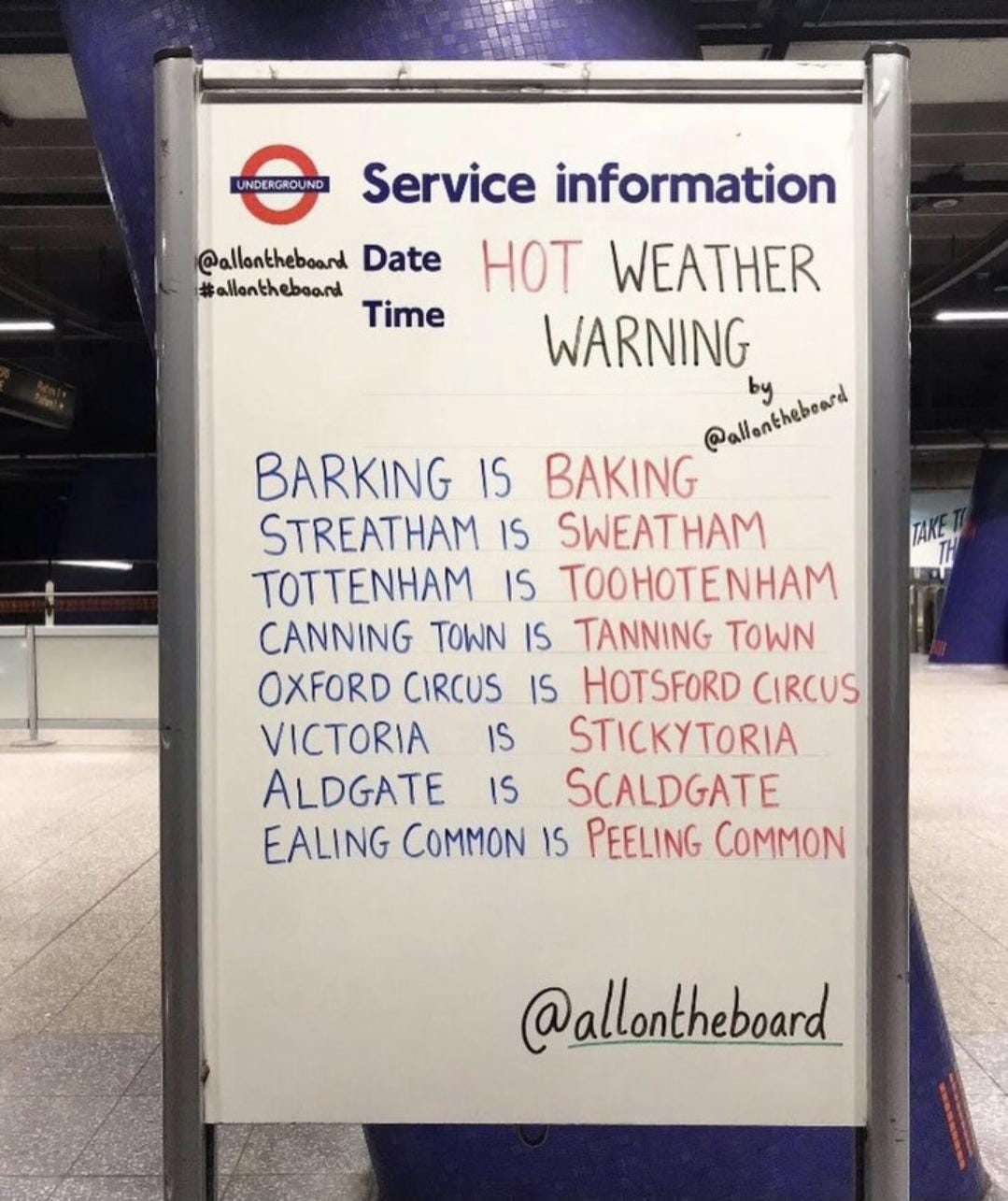'Housebuilding at risk for a decade': How data centres could overload the Docklands
Plus: Notting Hill Carnival ‘in jeopardy’, 32C temps recorded at Kew, and the final boss of Soho pop-ups

Morning — London’s AI and digital economy is booming, but not without cost.
Tower Hamlets council is warning of a looming electricity shortage, driven by a surge in energy-guzzling data centres on the Isle of Dogs. Without urgent upgrades to the grid locally, major housing schemes could be stalled for a decade or more, the council’s officers have warned.
It has echoes of the crunch already seen in west London, where data centre growth along the M4 corridor forced City Hall to step in and freeze housebuilding plans. Tower Hamlets, perhaps learning from that fallout, is already trying to act — with plans to impose stricter power limits on any new facilities.
How data centres could overload the Docklands is after your round-up below.
Plus: Notting Hill Carnival ‘in jeopardy’, 32C temps recorded at Kew, and the final boss of Soho pop-ups.
What we’ve spied
🔊 The organisers of Notting Hill Carnival have warned that the festival’s future is ‘in jeopardy’ if it doesn’t receive funding to address safety concerns. In a letter leaked to the BBC, carnival chair Ian Comfort has written to culture secretary Lisa Nandy to request more cash in order to keep “safeguarding the future and public safety of this iconic event". It follows the findings of an independent safety review commissioned by carnival organisers and paid for by City Hall as well as Kensington & Chelsea and Westminster councils which identified “critical public safety concerns” over crowd management. If Nandy grants the cash, it would be the first time national government has funded the carnival. The Met Police has also expressed concern about the need for extra security at the festival, having previously said it feared a “mass casualty event”. Sir Sadiq Khan said he shared police concerns, particularly around the risk of a crowd crush. Organisers now await a response from the government.
🥵 London is officially in the midst of a heatwave — temperatures have exceeded 28C three days in a row since Wednesday. A temperature monitor in Kew Gardens clocked in at 32.2C on Thursday, the highest in the UK in 2025 so far. The Met Office has issued an amber heat-health alert until Monday, and today (Saturday) is set to be another scorcher, with a high in London of 32C. The heatwave has led TfL to activate its hot weather plan on the Tube and to urge passengers to carry water. Meanwhile, London Fire Brigade has issued a wildfire warning.

🦶 Sir Sadiq Khan is moving ahead with Oxford Street pedestrianisation, after a consultation found 63% of Londoners support barring traffic from the flagship shopping street. The mayor says more detailed proposals on how he intends to pedestrianise Orchard Street to Great Portland Street will be published later this year, while a new mayoral development corporation will be established by 1 January 2026. This corporation will give Khan the legal power to pedestrianise Oxford Street by creating a zone where he’s in charge of planning, instead of the local borough council, Westminster.
Also, on Thursday, the mayor revealed the locations set to receive funding to support al fresco dining and drinking under his recently announced Summer Streets scheme. The winning spots are:
St Martin’s Lane in Westminster: The West End street, near Covent Garden, will be car-free from 11am to 11pm every day, with al fresco licenses available for up to 34 businesses.
Rivington Street and Redchurch Street in Shoreditch: “For the first time ever” bars and restaurants on the streets will be able to offer outdoor dining and drinking until midnight, and will be car-free on Fridays and Saturdays.
Atlantic Road + a “summer zone” in Brixton: Atlantic Road will be getting more “car free days” on select weekends through to October “to support local dining and entertainment”. In addition, central Brixton is getting its first “summer zone”, which will offer open-access outdoor seating on Saturday evenings “where people can relax with food, enhanced by live performances, workshops and Brixton’s market traders”.
Francis Road and Midland Road in Leyton: The former is having its car-free hours extended, while the latter is getting further outdoor dining.
The schemes have been welcomed by the hospitality industry — Michael Kill, CEO of the Night Time Industries Association, said: “The launch of al fresco dining in key areas like Brixton, Shoreditch, Leyton and the West End marks the beginning of an important initiative that supports the recovery and long-term growth of London’s nightlife and hospitality sector.”
🚇 The rollout of new trains for the Piccadilly line has been delayed by up to a year. The 94 fully walk-through trains with air con and CCTV were meant to be rolled out by late 2025 to replace the existing 1970s fleet, but TfL has now announced they’re coming in the second half of 2026. Testing for the trains is beginning this summer. Worth watching: in late 2023 transport YouTuber Geoff Marshall was flown out to a test track in Germany for an inside look at the new trains. Elsewhere in transport: Lime and Forest have been fined over £30,000 for abandoned e-bikes, following the introduction of TfL’s new enforcement policy on main roads last year.
📊 A recent poll suggests that more Londoners than not think gentrification is a “good thing”. Pollster YouGov published a survey earlier this week that found 37% of Londoners think gentrification is a “fairly” or “very good thing”, versus 27% who think it’s fairly or very bad. There was quite a lot of uncertainty though — 36% of Londoners said they didn’t know. But overall, YouGov’s poll found that London is more positive about gentrification than any other English region. The national split was 27% good vs 24% bad.
🎾 Campaigners in southwest London have raised £200,000 to fight the expansion of Wimbledon. The group Save Wimbledon Park is hoping to stop the All England Lawn Tennis Club’s plans to build 39 new courts and an 8,000-seat stadium on protected open land on Wimbledon Park. The plans were approved last September, but a two-day judicial review is set to take place later this year.
🌋 Locals in Rainham have won a court case over an illegal landfill that keeps spontaneously combusting — the notorious Launders Lane. On Tuesday the High Court ruled that Havering council’s decision to designate the dump as uncontaminated was "premature and unlawful", in a win for residents who’d brought the challenge under the banner of Clean the Air in Havering. The council will now need to reassess if the site is contaminated. For years now, the landfill has been catching fire during summer, and locals fear the smoke is having an impact on their health, especially since no one quite knows what’s buried at the site. One of our first ever Spy features was on the debacle, which dates back to dodgy dumping during the London Olympics — read it here.
🔍 And finally, we leave you with:
The final boss of Soho pop-ups (TikTok)
The billionaire landlord locked in a David v Goliath battle for London’s West End (Guardian)
Netflix’s new documentary on the Grenfell Tower fire (Netflix)
The curious case of Sadiq Khan’s new nightlife adviser (London Centric)
The best lidos and outdoor swimming pools in London (Time Out)
A new riverside walking and cycling route launching in north London (Time Out)
An average Monday in Hackney Wick (TikTok)
London’s lost Brutalist icon (TikTok)
£1,700,000 for a Highbury warehouse (TikTok)
Hounslow > south of France (TikTok)
The odd thing about Hounslow West (YouTube)
A data centre boom could stall housing in the Docklands for a decade
By the Spy

In London’s Docklands, the water that once powered shipping and trade now cools racks of blinking servers.
At Cloud House — a 40,000 sq ft data centre owned by Digital Realty — an elaborate system of pipes connects to Millwall Inner Dock.
Water is pumped up from the dock, fed through tubes in the server halls, then returned — all to keep the tech running at the optimal temperature.
"A combination of sensors and controls ensure that only the required volume of water is drawn, reducing our energy consumption and minimising our waste," explained a lead engineer in a recent promo video.
It's a key benefit of building a data centre on the Isle of Dogs, a peninsula once defined by shipping and heavy industry, now reinventing itself as a hub for the digital economy and AI.
Water aside, there's another big appeal: proximity to Canary Wharf and its banks, hungry for fast internet and computational might.
Business is booming — more than 20 data centres now operate on the Isle of Dogs and nearby South Poplar, according to one industry directory, many having come online in just the past few years.
But for all the innovation, a basic fact remains: data centres require an immense amount of power to run.
And the recent boom is threatening to push the local electricity supply to the limit.
So much so that there is now a "severe" risk of a lack of power for future housing in the Docklands, according to Tower Hamlet council documents uncovered by the Spy.
Keep reading with a 7-day free trial
Subscribe to London Spy to keep reading this post and get 7 days of free access to the full post archives.


